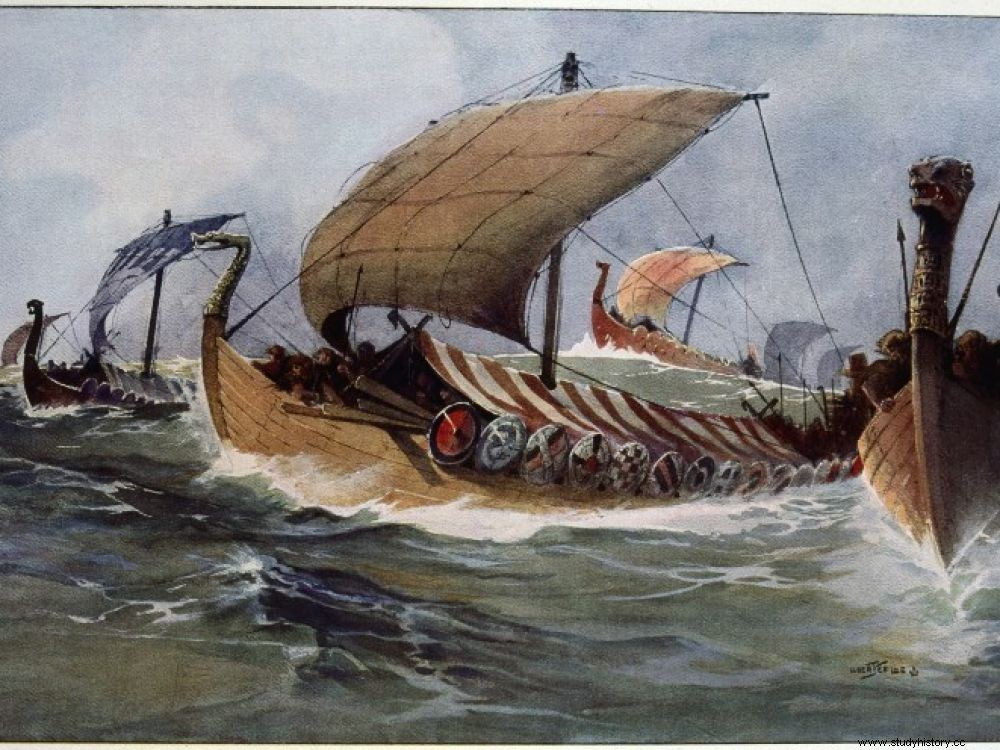Intensive tar production in Scandinavia from the 8th th century would have accompanied the dazzling development of the Viking fleet.

Viking fleet, canvas by the painter Albert Sebille (1874-1953)
Could a technological innovation explain Viking expeditions? In the Scandinavian domain, if the use of tar* and resinous substances to caulk (waterproof the hulls) langskip , snekkja , and other knorrs , was known to scholars, recent work in eastern Sweden sheds new light on their mode of production.
Viking funnels to extract tar
Andreas Hennius, an archaeologist at Uppsala University (Sweden), reports in a study published in the journal Antiquity how the preparation of tar on an industrial scale helped to increase Viking long-distance travel. The author explains that he has in fact discovered many structures in the form of funnels, connected to this exploitation, kinds of ovens, which made it possible to extract the tar from the slow combustion of pine wood, and some of which had the capacity to provide up to 500 liters of pitch - a derivative of tar. (The researchers estimate that 130 liters of this product were necessary to protect a langskip).
 Remains of an ancient tar kiln discovered in Uppsala, Sweden. © Andreas Hennius
Remains of an ancient tar kiln discovered in Uppsala, Sweden. © Andreas Hennius
Activity for domestic use practiced modestly in the IV e century, the proliferation of pits in direct proximity to forests from the 8 th century, would constitute, according to Andreas Hennius, proof of an exponential increase in the demand for tar. When the first kilns began to be unearthed in the province of Uppland, at the start of the 2000s, researchers first thought they were facing charcoal production sites, before realizing that these structures were related to that of tar.
In the XI th century, the era of the last expeditions, the Vikings are everywhere
"The intensification of maritime activities in the Viking Age probably increased the consumption of tar, which also became a commercial raw material", written Andreas Hennius. Ever larger ovens were made between 680 and 900, the period of Viking expansion. For this expert "the intensive preparation of tar also implied new methods of organization in the exploitation, the workforce, as much as the management of the forests and the transport". This production of tar is therefore synchronous with the evolution of shipbuilding and the Viking maritime influence.
In the XI th century, the era of the final expeditions, the Vikings are everywhere. They have been found since the end of the VIII th century in England where they attacked the monastery of Lindisfarne, on the coast of Northumberland; in the IX th century in Iceland, then from there to Greenland and even for a time on the American coasts, lands which they will call Vinland. Others will go east, and will reach the Black and Caspian Seas by going up the great Russian rivers.
The motivations of these Viking expeditions are still not fully understood by researchers, even if its sudden beginnings are to be linked to the improvement of navigation techniques, to climatic changes, or even to overpopulation... but also undoubtedly the lure of gain, with a very marked taste for the metal silver and the acquisition of wealth. Not to mention the adventure! Especially in a world where the sea was seen as a space conducive to looting. Be that as it may, the Scandinavian tar had a certain success, since in the XVII th century, French manufacture was no longer sufficient, it had to be imported from Northern Europe, in particular from Stockholm. Conifer tar (pitch or pitch), Sweden's main export product in modern times, was a strategic material in the 17th century. and XVIII th century in France, when the navy took off under the impetus of Colbert.
* Word of Arabic origin, tarqaṭrān is of two types:vegetable tar, a resinous product extracted by pyrolysis of wood or bark; and tar of geological origin (bitumen, coal tar or shale).
